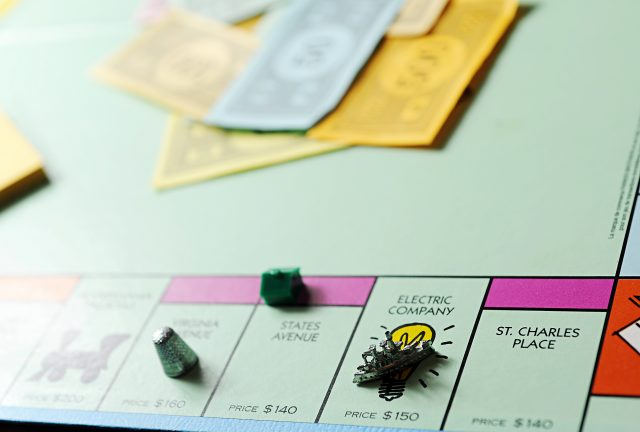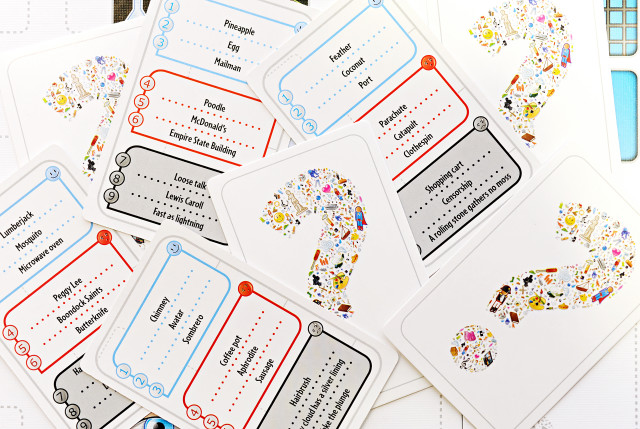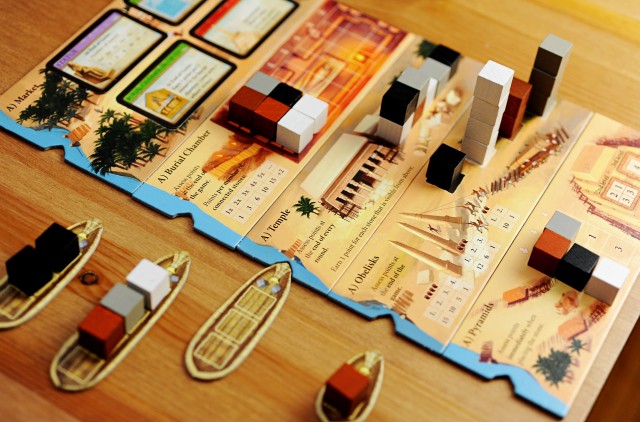The board game industry is huge, and it has been growing consistently for the last two decades. Since the dawn of time, mankind has created 60-70,000 games, with 99% of them within the last century. Games are used by intelligence agencies to train spies, by medical professionals to help patients stave off dementia, and many universities around the world offer degrees in board game design. Still, despite all that, when you mention board games to the average person on the street, they immediately think “Monopoly, Clue, and Candyland.” To the vast majority of people, board games are something for kids; they are unaware of the myriad delights and challenges that board games offer to the adult mind.
 One segment of the board game industry that has been on the rise in the last decade or so is the board game cafe. The term refers to restaurants or bars that provide a selection of board games to play along side their food and drink offerings. Most people have been to a pub trivia night, or have been to a bar that has a Chess set or two, and a Scrabble set that may or may not be missing some letters, but what separates these places from true board game cafes is the huge selection of games on offer. A true board game cafe will have hundreds, or even thousands of games in its library. More games than the average board game consumer has ever heard of. A board game cafe sounds like a haven for game nerds (I say this as one), but in truth, the game nerd (or as many of us prefer to be known, hobbyist) market is still too small to keep businesses like this profitable. They survive and thrive by being accessible to the casual gamer and the non-gamer, as well; the people for whom childhood games of Risk, or after dinner rounds of Taboo or Pictionary make up the entirety of their gaming experience. Board game cafes know how to entertain these people, and turn some of them into hobby gamers along the way.
One segment of the board game industry that has been on the rise in the last decade or so is the board game cafe. The term refers to restaurants or bars that provide a selection of board games to play along side their food and drink offerings. Most people have been to a pub trivia night, or have been to a bar that has a Chess set or two, and a Scrabble set that may or may not be missing some letters, but what separates these places from true board game cafes is the huge selection of games on offer. A true board game cafe will have hundreds, or even thousands of games in its library. More games than the average board game consumer has ever heard of. A board game cafe sounds like a haven for game nerds (I say this as one), but in truth, the game nerd (or as many of us prefer to be known, hobbyist) market is still too small to keep businesses like this profitable. They survive and thrive by being accessible to the casual gamer and the non-gamer, as well; the people for whom childhood games of Risk, or after dinner rounds of Taboo or Pictionary make up the entirety of their gaming experience. Board game cafes know how to entertain these people, and turn some of them into hobby gamers along the way.
At any of the Snakes & Lattes cafes in Toronto (the world’s most famous chain of board game cafes) for every copy of Agricola, Twilight Struggle, or Dominant Species that they have in their library for the serious hobbyist, there are four or five copies of Connect 4, Guess Who, Cranium, or Life, because these are the games that non-gamers expect to see; the games that send them on a nostalgic journey back to their childhoods. Without the heavy strategy games and the “Classic Americana” games (as Snakes & Lattes calls them), the two most important segments of the game cafe audience will leave disappointed. But it’s in between those two extremes that the magic happens; it’s where the hidden gems lie that can open up a non-gamer’s horizons, and make them see just what games have to offer, and make them see what we in the hobby already know: games are awesome.
 If you have friends that you are having trouble converting to the hobby, or you are new to the hobby, yourself, and don’t know where to start, this list will be your best friend. This list will omit Catan, and any other games popular enough to have made it to the shelves of your nearest Barnes & Noble, Toys R Us, or Walmart. It will also skip over the Exploding Kittens, Cards Against Humanities, and Munchkins of the world, because if you want to introduce your friends to good games, you’ll also want to skip over those titles. This list focuses on the games that haven’t achieved the popularity to become household names, and that hobbyists may have overlooked thinking them too simple for their tastes. These fifteen games are perfect to hook newcomers, while still being engaging enough to keep seasoned gamers entertained, so whether you’re looking to explore a new hobby for yourself, or you’re trying to introduce your friends and family to your favourite pastime, give these games a look.
If you have friends that you are having trouble converting to the hobby, or you are new to the hobby, yourself, and don’t know where to start, this list will be your best friend. This list will omit Catan, and any other games popular enough to have made it to the shelves of your nearest Barnes & Noble, Toys R Us, or Walmart. It will also skip over the Exploding Kittens, Cards Against Humanities, and Munchkins of the world, because if you want to introduce your friends to good games, you’ll also want to skip over those titles. This list focuses on the games that haven’t achieved the popularity to become household names, and that hobbyists may have overlooked thinking them too simple for their tastes. These fifteen games are perfect to hook newcomers, while still being engaging enough to keep seasoned gamers entertained, so whether you’re looking to explore a new hobby for yourself, or you’re trying to introduce your friends and family to your favourite pastime, give these games a look.
PARTY GAMES
While most of us game nerds perfer games with more meat on their bones, good party games are usually the best way to hook non-gamers. Sure, you may want a three course meal, while your friends just want pizza, but if the pizza is good enough, you can all enjoy it.
Codenames (2015) by Czech Games Edition and designer Vlaada Chvatil has won numerous awards, including the coveted Spiel Des Jahres in 2016. Two teams of spies attempt to make contact with all their agents before their opponents do. Each team has a Spy Master who gives clues to help the team guess which of the 25 words on the grid are theirs. Being the Spy Master takes some out of the box thinking, but the reward is worth the challenge. Codenames plays great with as few as four players and accommodates large groups as well.
Concept (2013) from Asmodee, designed by Gaetan Beaujannot & Alain Rivellot is another award winner and SDJ nominee. It is a guessing game, like charades, but instead of acting clues out, they place plastic markers on a board  covered in emoji-like symbols. Each symbol has a variety of suggested possible meanings, but it is up to the players to make sense out of the various clues in context. Concept is great for small or large groups.
covered in emoji-like symbols. Each symbol has a variety of suggested possible meanings, but it is up to the players to make sense out of the various clues in context. Concept is great for small or large groups.
Funemployed (2014), designed by Anthony Conta, and recently re-released by toy giant Mattel, is a great alternative to Apples to Apples or Cards Against Humanity. It’s a game of ridiculous job interviews and absurd qualifications. Players compete for jobs like “spy,” “head master,” or “car salesperson” by using cards with qualifications like “foreign accent,” “daddy issues,” or “nunchucks.” Each round one player is the employer, and the candidate who makes the best case with their four qualification cards gets the job.
DEXTERITY GAMES
Dex games are another genre of games that are great for grabbing the attention of new gamers. Any game that requires fast reflexes or hand-eye co-ordination creates a sense of tension, competition, and down right fun that can put many strategy games to shame.
 Riff Raff (2012), by designer Christoph Cantzler and publisher Zoch, is a game for 2-4 stevedores trying to load cargo onto a constantly pivoting boat. Riff Raff combines the need for steady hand AND fast reflexes.
Riff Raff (2012), by designer Christoph Cantzler and publisher Zoch, is a game for 2-4 stevedores trying to load cargo onto a constantly pivoting boat. Riff Raff combines the need for steady hand AND fast reflexes.
Ghost Blitz (2010), by Jacques Ziemet, is another great dex game from Zoch. Players compete to collect cards by being the first to grab the right object off the table. The right object to grab depends on what’s shown on the card. Speed and pattern recognition are the keys to victory.
STRATEGY GAMES
Strategy games are the heart of the modern gaming hobby. They come in all types, sizes, and complexities. Many hobbyists love the heavy ones, but they make for an intimidating introduction for most newcomers. The following titles won’t scare anyone off, and won’t bore a board game afficianado.
Indigo (2012) by Reiner Knizia, published by Ravensberger is a wonderful path-laying game for 2-4 players. Players lay tiles on the board to create pathways which cause gems to move around the board. If you make a gem leave the board through a space you own, you score points. When all the gems are claimed, the highest score wins the game. The twist is, that depending on the player count, you will share ownership of some of your exit spaces with another player, so when you score points, so do they. And vice versa.
 No Thanks (2004) by Thorsten Gimler and Zman Games is a simple to learn card game for 3-5 players that encourages you to score as few points as possible. Cards you collect are worth points, and you can avoid taking a card by placing one of your limited chips on it, and making the card the next player’s problem. But watch out, if you run out of chips, you will have to take every card that comes your way. The good news is that every chip paid so a player can avoid a card is collected by whoever finally takes the card.
No Thanks (2004) by Thorsten Gimler and Zman Games is a simple to learn card game for 3-5 players that encourages you to score as few points as possible. Cards you collect are worth points, and you can avoid taking a card by placing one of your limited chips on it, and making the card the next player’s problem. But watch out, if you run out of chips, you will have to take every card that comes your way. The good news is that every chip paid so a player can avoid a card is collected by whoever finally takes the card.
Qin (2012) by Reiner Knizia and published in North America by R & R Games is a tile-laying and area control game for 2-4 players. Each player starts with the same number of control pagodas and a hand of three tiles. By playing tiles on the board, players can create provinces, and creating provinces lets them put their pagodas in play. The first player to place all their pagodas is the winner. Provinces can be absorbed by larger once, forcing the player of the absorbed province to remove their pagoda.
Flash Point (2011) by Kevin Lanzing and Indie Boards & Cards is not as well known as its predecessor in the genre of co-operative games, Pandemic, but it packs the chaotic thrill of firefighting into a board game. 2-6 players work together to save at least 7 of the 10 victims who are trapped in a burning house. For added flexibility as an entry point into the game hobby, Flash Point has a family mode and an advanced mode all in one box allowing players to tailor the complexity and challenge of the game to their needs.
 Lords of Waterdeep (2012) by Peter Lee & Rodney Thompson, published by the Wizards of the Coast division of Hasbro is an easy to intuit worker placement game set in the world of D&D (don’t worry, you don’t need to know anything about D&D to enjoy Waterdeep). Each player has a set of workers (I like to call them “minions”), that they take turns placing at the various available spaces on the board. Each space performs a function when occupied by a minion, but if it’s already occupied, you have to find somewhere else to send you. Use your minions to collect the resources you need to complete quests and earn points. Intrigue cards allow players to mess with each other on their way to victory.
Lords of Waterdeep (2012) by Peter Lee & Rodney Thompson, published by the Wizards of the Coast division of Hasbro is an easy to intuit worker placement game set in the world of D&D (don’t worry, you don’t need to know anything about D&D to enjoy Waterdeep). Each player has a set of workers (I like to call them “minions”), that they take turns placing at the various available spaces on the board. Each space performs a function when occupied by a minion, but if it’s already occupied, you have to find somewhere else to send you. Use your minions to collect the resources you need to complete quests and earn points. Intrigue cards allow players to mess with each other on their way to victory.
Cartagena (2000) by Leo Colovini and Ravensberger shares some DNA with Candyland. Unlike the simplistic children’s game whose outcome is determined once the cards are shuffled, however, Cartagena gives players choices to make every turn, and those choices will determine victory. Players compete to break their five pirates out of prison. The first to navigate all their Pirates down the path to the escape boat wins. Pirates move forward by playing cards that have pictures matching the spaces on the path. Pieces move to the first empty space with the corresponding picture. To get more cards, players must retreat a pirate back up the path. Players then draw one card for each pirate that was on the space (one or two) before their new pirate got there.
Century: Spice Road (2017) by Emerson Matsuuchi and Plan B Games is an economic engine building game set in the world of medieval spice traders. Players take turns playing action cards to collect more spices, or trade current spices for different ones. There is a market line of action cards that can be bought with spices (these action cards are more elaborate and valuable than players’ starting action cards), and there is a second line of cards that are worth victory points if you can meet their spice requirements.
Deception: Murder in Hong Kong (2014) by Tobey Ho and Grey Fox Games is the spiritual descendant of other “social deduction” games like the Resistance, and Werewolf. In it, players (anywhere from 3-12) are trying to either solve, or get away with, a murder case. One player is the Forensic Scientist, and all the other players are dealt secret cards which dictate if they are Investigators or the Murderer. Players are also give a set of public evidence cards. The Forensic Scientist knows the Murderer, and which two evidence cards the Murderer used, and they must, silently, guide the Investigators to the solution, using a partially random set of clue boards. Great for people who think Clue was the most awesome game ever!
 Imhotep (2016) published by Kosmos, and designed by Phil Walker-Harding is a classic example of Euro-style games. It has a historical theme (ancient Egypt), it avoids direct conflict and player elimination, uses wooden cubes instead of plastic figures, and it gives players plenty of choices to make for how best to go about earning victory points and winning the game. 2-4 players are architects building pyramids, obelisks, and other monuments to the glory of the pharaoh, allocating their stones to boats headed to the different building sites, and earning their leader’s favour in the process.
Imhotep (2016) published by Kosmos, and designed by Phil Walker-Harding is a classic example of Euro-style games. It has a historical theme (ancient Egypt), it avoids direct conflict and player elimination, uses wooden cubes instead of plastic figures, and it gives players plenty of choices to make for how best to go about earning victory points and winning the game. 2-4 players are architects building pyramids, obelisks, and other monuments to the glory of the pharaoh, allocating their stones to boats headed to the different building sites, and earning their leader’s favour in the process.
Yinsh (2003) by Chris Burm, part of Rio Grande’s GIPF Project is ideal for players who like the head to head challenge of abstract games. Like checkers, backgammon, or Connect 4, Yinsh doesn’t bother with a theme or story. It makes do with a set of black and white pieces, simple rules, and ensures that victory is as hard to achieve as your opponent is clever. Players use their ring pieces to place and flip stones in an effort to create rows of five of their colour stones. Every time they succeed, they remove a ring and earn a point. First person to 3 points wins.
[…] Gateway Games from a Guru – Daily Worker Placement Board Game cafes draw in all kinds of people – many of which don’t know the depths of the hobby. Here are some games to get them started. […]
[…] + 여기서 자세히 보기 […]